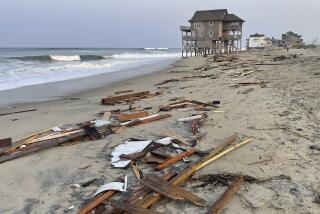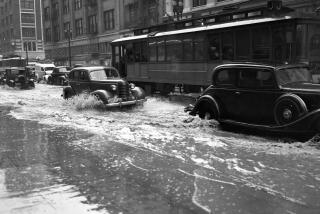Eminence Grise of Hurricane Forecasting
FORT COLLINS, Colo. â A mile above sea level, surrounded by gunmetal-gray filing cabinets and floor-to-ceiling bookshelves bursting with papers and weather maps, sits the man many consider the dean of hurricane forecasting in the United States.
From his office at Colorado State University at the foot of the Rocky Mountains and 65 miles north of Denver, William M. Gray pioneered the concept of âseasonalâ hurricane forecasting -- predicting months in advance the severity of the coming hurricane season. Grayâs prognostications, issued since 1983, are used by insurance companies to calculate premiums, media outlets to remind coastal residents of the hazards of bad weather, and even storm window manufacturers who have cited the forecasts in their sales pitches.
This year he predicts nine hurricanes, with a 55% chance of landfall in the United States. He will update that forecast Wednesday.
Gray, 76, is a throwback in the field of climatology. He eschews the elaborate mathematical models that are increasingly used to predict weather, preferring to scour through the thick files of historical storm data that cram his office. Heâs the sort who reads old maps of storm patterns for fun rather than booting up his laptop, and embarks on frantic searches for old academic papers while proclaiming that âa professor should never be able to find anything in his office.â
âThe whole secret is to look globally,â Gray, who once hoped to be a geographer, said of his forecasting methods. He looks at the rainfall in West Africa, the water temperature in the Pacific, whether it has been warm in the northeastern United States. âIf you combine all these things, thereâs some memory that the atmosphere has of whatâs going to come in the future.â
That global mind-set may help explain how Gray has been able to spend most of his professional life about as far from saltwater and tropical humidity as is possible in the continental U.S. Gray has traveled all over the world in his studies, but he always returns to the landlocked Fort Collins campus, which has, paradoxically, become a national powerhouse in training tropical storm forecasters.
âYou donât have to live on the surface of Mars to study its atmosphere,â Gray said in an interview.
The Korean War made Gray a climatologist. Wary of being drafted into combat, Gray signed up with an Air Force program that would fund graduate work in climatology in exchange for three years of service as a meteorologist. In 1953, Gray was stationed in the Azores, a remote patch of Portuguese volcanic islands in the middle of the Atlantic, between the northeastern United States and England.
After he ended his service, he enrolled at what was then the top climatological school in the country, the University of Chicago, and studied under legendary meteorologist Herbert Riehl.
What helped cinch Grayâs career choice was a flight in a B-50 through the 125-knot winds of Hurricane Helene off the east coast of Florida in 1958, skimming low enough to see the titanic waves kicked up by the storm. âTake a young graduate student, fly him into waves and he gets excited,â Gray said.
Riehl was lured by Colorado State in 1960 to found a climatology department, and he brought Gray to the quiet college town where the high plains butt up against the mountains. The two created a world-renowned graduate program that cranked out a number of tropical storm specialists.
After 20 years of studying tropical cyclones Gray carved out the niche that made him famous -- at least for an academic forecaster.
The head of the National Hurricane Center had bemoaned the inability to predict the severity of the next hurricane season. Gray started puzzling through the basic storm theory he had been teaching for decades and wondered if there was a way to look at atmospheric factors and extrapolate what might happen in the months ahead.
His first forecast was a sensation. âAnyone who could say anything about the coming season, that was big stuff,â Gray said.
Now several scientists and institutions formally predict the coming season, including the National Hurricane Center, where two of Grayâs students work on the forecast. Grayâs own forecasts begin in December, predicting storm activity nearly nine months in advance. He refines them as more data comes in, tweaking his prognostications through the summer hurricane season.
In December 2004, Gray predicted that the 2005 hurricane season would see 11 storms strong enough to earn names. As he watched the weather patterns grow increasingly violent, he steadily increased his predictions. By August, he had upped the forecast to 20. Twenty-eight were ultimately recorded for the season.
This year, Gray is scaling back on forecasting. As an emeritus professor, he has no teaching responsibilities, but he is handing off prime authorship of the forecast to a graduate student, Philip J. Klotzbach, and is turning his energies toward trying to refute global warming.
Like many hurricane forecasters, Gray rejects the theory that the recent uptick in storms is due to climate change. He points out that the U.S. had an unusually low number of storms from the 1970s to the end of the century and says the law of averages is simply catching up. But he goes further and dismisses the view -- accepted as fact by most scientists -- that recent warmer temperatures are caused by man-made greenhouse gases.
âItâs one of the greatest hoaxes ever,â Gray says of global warming, theorizing that itâs an alarmist hypothesis made to snare research dollars. Gray believes that climbing temperatures are caused by cyclical warming in the oceans, and that the globe will cool down again in the next 10 to 15 years.
Klotzbach, Grayâs coauthor on the forecast, says his mentorâs underdog position in the global warming debate is typical. âHeâs not one to just go along with the crowd,â Klotzbach said.






